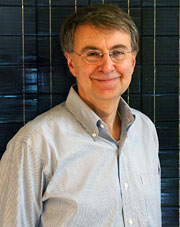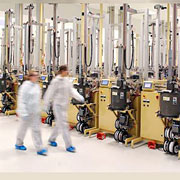Building solar cells from ribbons
Reducing the cost of solar power requires slashing the cost of manufacturing the silicon wafers on which solar cells are built. A technique first proposed in the 1980s by Professor Emanuel M. Sachs of mechanical engineering is doing just that by doubling the number of wafers made per pound of expensive silicon.
According to Sachs, if photovoltaic (PV) solar power is to compete economically with conventional power sources, the total cost of manufacturing PV systems must drop by a factor of three or more. Making silicon wafers currently accounts for 45 percent of that total cost.
In Sachs’s view, it’s all about waste. The conventional way to make silicon wafers is to cast a solid brick of silicon and then slice it into wafers. But slicing makes dust, and in this case the dust is expensive silicon, no longer pure enough to be recycled.
"Most wafer manufacturers today effectively throw away half of their highly refined silicon starting material," said Sachs.
So he came up with an approach that does away with slicing. Instead of making bricks, his String Ribbon process makes long sheets of silicon just the thickness of a wafer. No slicing, no waste.
The String Ribbon process
To make the sheets, two high-temperature strings, or filaments, rise through a shallow crucible of molten silicon. A thin film of silicon spans the space between them, supported at the edges by the strings. “It’s like pulling a wand out of a soap solution,” Sachs said, “and the edge of the wand holds the soap film in place.” But in String Ribbon the film instantly turns solid, forming an 8-centimeter-wide silicon ribbon, just 200 microns thick.
The process is continuous. Chunks of silicon enter the furnace and melt, the strings unwind from spools, and the emerging ribbon is cut to 2-meter lengths without stopping. Each ribbon is then laser-cut into wafers, which go directly onto a belt for the next step in becoming solar cells and ultimately high-efficiency solar panels.
In 1994, Evergreen Solar, Inc., began manufacturing crystalline silicon PV modules using the String Ribbon approach. Today, a plant in Marlborough, Massachusetts, operates 120 machines that manufacture 15 megawatts (MW) of PV panels annually, and a plant in Thalheim, Germany, is manufacturing another 30 MW annually. Together, the plants make up about 1.5 percent of all global production of PV modules.
While the global market is growing at a healthy 35 percent per year, Evergreen’s production is growing at somewhat over 100 percent annually. And the process itself continues to improve. Eight new machines in Marlborough will grow four ribbons side by side from a single crucible that is smaller and specially shaped so that its edges don’t pull the emerging ribbon askew.
Moving to renewable energy
While Sachs is a strong advocate of photovoltaics, he is adamant that we develop all the renewable technologies plus energy-storage devices to support them. In his view, we must ultimately get all of our energy from renewable sources—a transition that may take 50 years. Witness past transitions from wood to coal and from coal to oil.
Are the renewables up to the task? Sachs has no doubt. According to his calculations, solar alone could meet U.S. energy demand. Covering 2 percent of the continental United States with PV systems that are just 10 percent efficient would do the trick, contingent on breakthroughs in energy-storage technology.
“People at first react to that as preposterous,” he said. “But we’ve already covered 1.5 percent of the country with roads, so we can in fact create manmade ‘stuff’ that covers that amount of land.” We also use 20 percent of our land to grow crops and another 20 percent to graze animals.
“So rather than being hunter-gatherers for hard-to-find fossil fuels, we can become farmers, harvesters of energy,” he said.
Sachs’ PV research group is now working on light trapping, cell metallization, and module fabrication.
—Nancy Stauffer
Early research on String Ribbon was supported by the Hertz Foundation.



